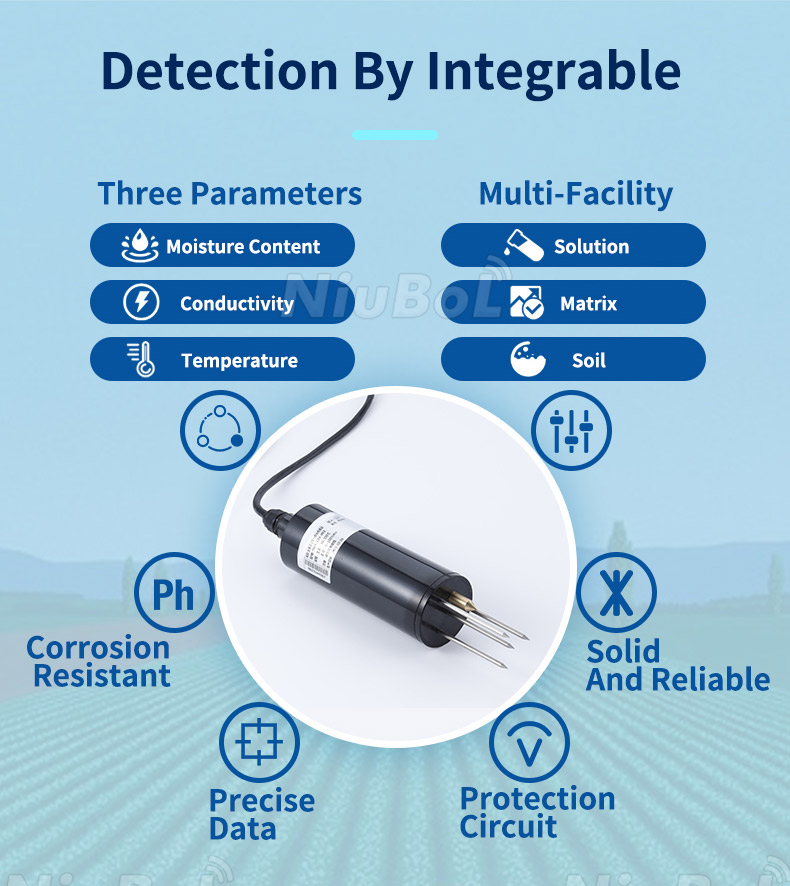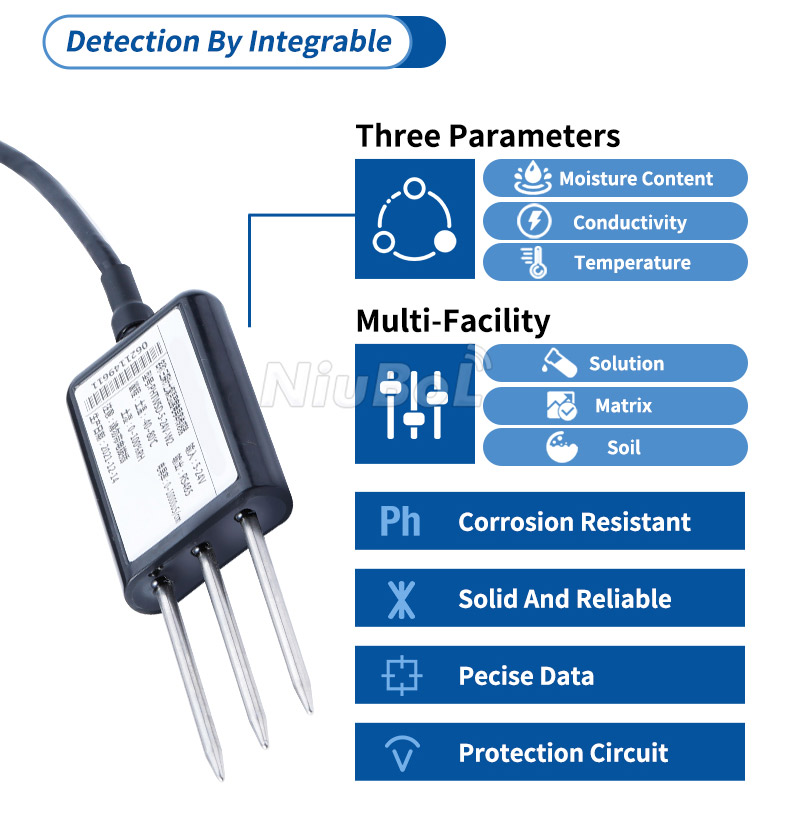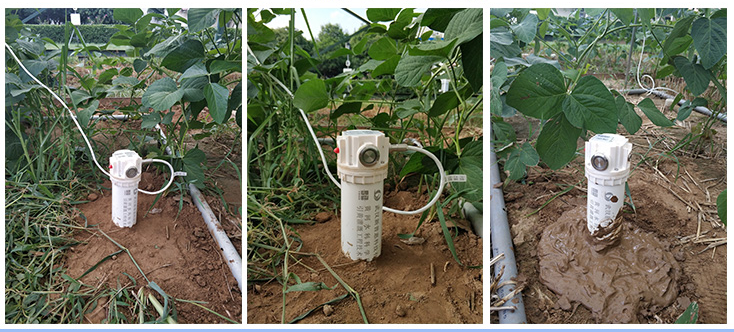

— Blogs —
—Products—
 Consumer hotline +8618073152920
Consumer hotline +8618073152920 WhatsApp:+8615367865107
Address:Room 102, District D, Houhu Industrial Park, Yuelu District, Changsha City, Hunan Province, China
Technical Support
Time:2024-09-29 21:31:15 Popularity:2127
The temperature measurement method uses a thermistor. The resistance value of the thermistor changes with temperature. By measuring the change in resistance, the soil temperature can be calculated.
Moisture measurement is primarily based on the interaction between the physical properties of the soil and electronic components. Dielectric constant-type moisture sensors emit small high-frequency electromagnetic waves and detect the phase delay or attenuation after passing through the soil to estimate soil moisture content. Resistance-type moisture sensors measure changes in soil conductivity to reflect soil moisture; when the soil is wet, its conductivity increases, and the resistance value decreases.
TDR (Time Domain Reflectometry) and FDR (Frequency Domain Reflectometry) are two common soil moisture measurement technologies that have wide applications in agriculture, environmental monitoring, and scientific research. Below is a detailed introduction to TDR and FDR:
TDR (Time Domain Reflectometry)
TDR uses a crystal oscillator to generate high-frequency signals, which are then transmitted to metal probes. As these signals propagate through the soil, they interact with water and other components, causing reflections and attenuation. By measuring the round-trip time and amplitude changes of the signal, the dielectric constant of the soil can be calculated, allowing for the estimation of soil moisture. TDR results are independent of soil type, density, and temperature, offering strong independence.

- High accuracy: TDR provides highly accurate soil moisture data.
- Strong independence: Measurement results are not affected by soil type, density, or temperature.
- Wide applicability: Suitable for measuring moisture in various soil types.
- Higher cost: TDR equipment tends to be relatively expensive, potentially increasing usage costs.
- Complex data analysis: Data generated by TDR requires specialized software for analysis and processing.
FDR (Frequency Domain Reflectometry)
FDR operates on the principle of electromagnetic pulses. It estimates the apparent dielectric constant (ε) of the soil by measuring frequency changes of electromagnetic waves as they propagate through the soil, which helps determine the volumetric water content (θv). FDR sensors typically use an oscillator to propagate electromagnetic signals through metal spikes or other waveguides and measure the frequency difference between outgoing and returning waves to determine soil moisture.
- Fast response: FDR sensors have quick response times, capable of reflecting real-time changes in soil moisture.
- Lower cost: Compared to TDR, FDR equipment is more economical, facilitating broader adoption.
- Easy calibration: While FDR sensors need soil-type-specific calibration, the calibration process is relatively simple.

- Precision affected by soil type: The measurement accuracy of FDR may be impacted by soil type and structure.
- Limited applicability: In some soil types, FDR measurements may not be sufficiently accurate.

Both TDR and FDR are effective soil moisture measurement technologies, each with its own advantages and disadvantages. When choosing which technology to use, it’s essential to consider the specific application scenario and needs. For example, TDR may be more suitable in situations requiring high-precision measurements with complex soil types, while FDR presents advantages in scenarios needing fast responses and lower costs.
NBL-S-TM or NBL-TMC are resistance-type soil moisture sensors using FDR technology.
NBL-S-TMM is a capacitance-type soil moisture sensor using FDR technology.
NBL-S-THR is a resistance-type soil moisture sensor using TDR technology.
NBL-S-THR-Soil-temperature-and-moisture-sensors-Instruction-Manual-V4.0.pdf
NBL-S-TM-Soil-temperature-and-moisture-sensor-Instruction-Manual-4.0.pdf
NBL-S-TMC-Soil-temperature-and-moisture-conductivity-sensor.pdf
NBL-S-TMM-Tubular-Multi-Layer-Soil-Moisture-Sensor-Meter.pdf
Related recommendations
Sensors & Weather Stations Catalog
Agriculture Sensors and Weather Stations Catalog-NiuBoL.pdf
Weather Stations Catalog-NiuBoL.pdf
Related products
 Combined air temperature and relative humidity sensor
Combined air temperature and relative humidity sensor Soil Moisture Temperature sensor for irrigation
Soil Moisture Temperature sensor for irrigation Soil pH sensor RS485 soil Testing instrument soil ph meter for agriculture
Soil pH sensor RS485 soil Testing instrument soil ph meter for agriculture Wind Speed sensor Output Modbus/RS485/Analog/0-5V/4-20mA
Wind Speed sensor Output Modbus/RS485/Analog/0-5V/4-20mA Tipping bucket rain gauge for weather monitoring auto rainfall sensor RS485/Outdoor/stainless steel
Tipping bucket rain gauge for weather monitoring auto rainfall sensor RS485/Outdoor/stainless steel Pyranometer Solar Radiation Sensor 4-20mA/RS485
Pyranometer Solar Radiation Sensor 4-20mA/RS485
Screenshot, WhatsApp to identify the QR code
WhatsApp number:+8615367865107
(Click on WhatsApp to copy and add friends)
